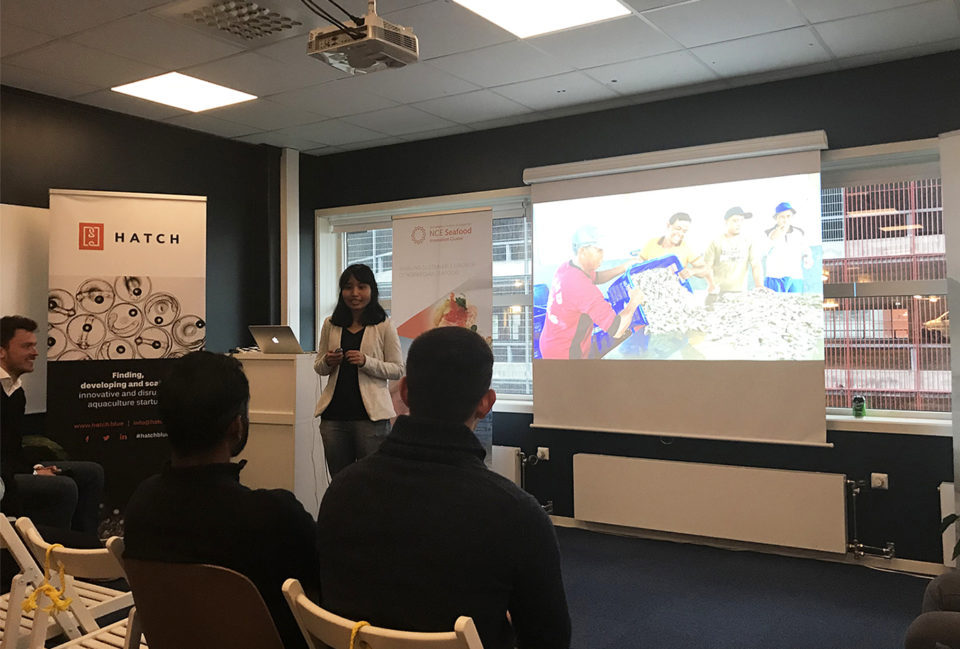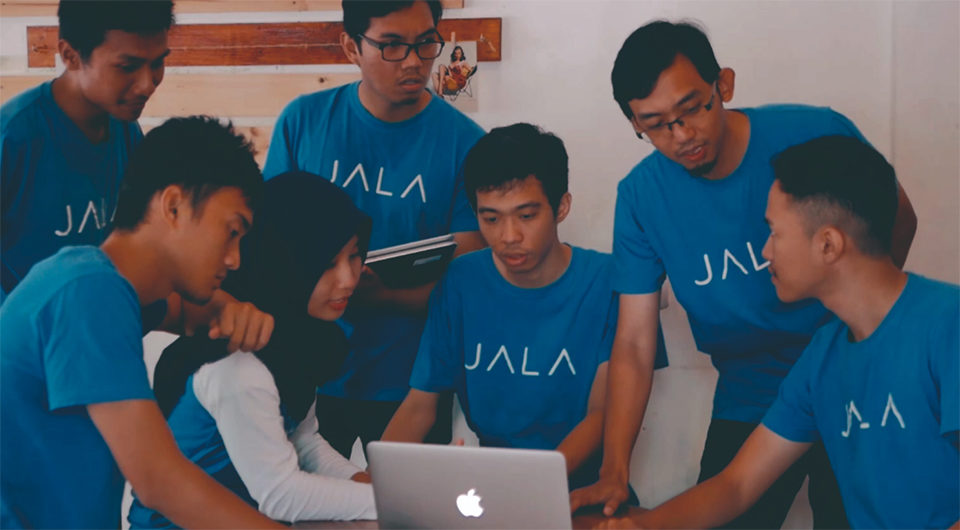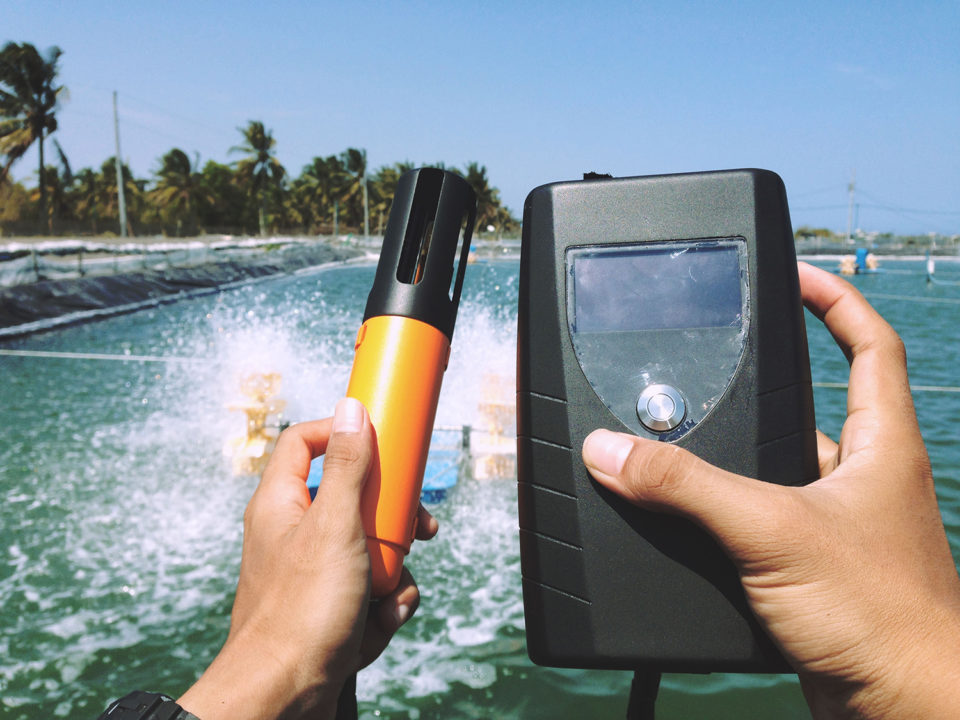Startup fresh out of Hatch program offers IoT sensor, online monitoring service to Southeast Asia producers

Lots of devices have proved their usefulness on shrimp farms over the years, from paddlewheels to feed trays and from Secchi discs to Imhoff cones.
The gadgets of tomorrow are arriving, as a rapidly growing set of tools connect computers to the physical world. Billions of “smart” devices are part of the so-called Internet of Things, or IoT: Think fully automated home security systems controlled by smartphone apps and refrigerators that send notifications when the milk is about to spoil.
A company from Indonesia hopes that the vast network of labor-intensive shrimp farms throughout the country will see the benefit from adopting IoT technology, particularly when operators are on the go. Since forming in 2015, JALA has been selling a water-monitoring device to shrimp farmers that measures key variables and relays any sudden changes immediately. The data-driven management system allows producers to make fast decisions at the pond side or from thousands of miles away.
JALA is now positioned for a new growth curve after recently participating in the inaugural cohort of the Hatch program, a global aquaculture business accelerator looking for promising businesses that want to become more attractive to investors. (Click here for profiles on other Hatch startups, including Manolin, Verifik8 and Aquaconnect.)
Liris Maduningtyas, CEO and co-founder of the venture, told the Advocate that the Hatch experience – which took place some 10,000 kilometers away in Bergen, Norway – gave her team new ideas about how to grow their business.
“It gave me a different perspective to see how we can scale our business in the aquaculture landscape,” she said. “I was also surrounded by people who speak the same language and share the same passion for aquaculture and that was really helpful.”
Much like India-based Aquaconnect, JALA (registered under PT. Ekotekno Wcaksana in Indonesia and JALA TECH Pte. Ltd. in Singapore) provides both hardware and software products that monitor farming conditions. JALA has developed a water-probe device with sensors that measure dissolved oxygen, temperature, pH, salinity and total dissolved solids.

The device shares the data it collects with operators in real time, online and via SMS when data service is unavailable. JALA believes that by relying on accurate and timely data, as opposed to a farmer’s intuition, better management of water conditions on shrimp farms will optimize the sector’s performance.
The company’s prototype device, first known as the Blumbangreksa, was a bit too bulky, said Madungingtyas. It had “off-the-shelf” modules, an external broadband dongle, monochrome display and “many buttons,” she said.

“This is in contrast to the current JALA continuous device, which is lighter, with a sleeker design, a 3D-printed enclosure, colored LED screen and just a single action button,” Madungingtyas said. Each pond needs a sensor device, but only one portable device to monitor them all. “We also applied RFID identification. Each pond has its own RFID card, so this one device can be used to monitor water quality of several ponds.”
The monthly subscription service is $24 per pond, she added, and the company currently has 20 farmers enrolled, with a total of 160 ponds located in Yogyakarta, Central Java, West Java and Lampung, Indonesia.
Carsten Krome, Ph.D., the founder of Hatch, said JALA has gained a lot of traction over the past months.
“Their product is interesting to smallholders and corporate farmers alike,” said Krome. “Feed manufacturers have also seen Jala’s technology as a means to get a better understanding of what is going on in the ponds. The technology is easy to use and provides direct savings to farmers. Key is to provide simple farm management recommendations and not overburden farmers with complicated graphs and metrics and Jala have really figured this out.”
The JALA team is a combination of engineers blended with some aquaculture experience: Co-founder and Chairman Aryo Wiryawan is a shrimp farmer since 2001 and also the director of Indirma, a research company focusing on agriculture and aquaculture. Three years ago, Wiryawan gathered a group of electrical engineers at Gadjah Mada University in Yogyakarta to brainstorm the makeup of the device. Maduningtyas, whose background is in data engineering, joined the company after the proof of concept.
Since Hatch, she said JALA attained a lead investor and is seeking others. Her charm, as was evident during a May presentation at the NEC Seafood Innovation Cluster in Bergen, may take JALA as far as its device’s technical capabilities.
During her informal “elevator pitch” presentation, given mid-way through the three-month Hatch program, she won over a small gathering of guests and colleagues with humor. She described how hard the JALA team has worked to establish itself with shrimp farms in Indonesia, to better understand their needs: “I would work with the farmers. I would eat with the farmers. I would drink with the farmers. I would sleep … on the farms.”
The company plans to expand to Thailand and Vietnam next year.
Follow the Advocate on Twitter @GAA_Advocate
Author
-

James Wright
Editorial Manager
Global Aquaculture Alliance
Portsmouth, NH, USA
Tagged With
Related Posts

Responsibility
App aims to bring clarity to seafood traceability, social compliance data
For small-scale aquaculture farmers in far-flung regions, creating traceability data can present major challenges, both linguistic and technological. It’s those challenges that VerifiK8 is poised and ready to help solve.

Innovation & Investment
Now Hatching: Millennial duo’s aquaculture analytics software
In the first startup profile of the inaugural Hatch cohort in Bergen, meet two young software developers who left Washington, D.C., for Norway and the power of personal connections to grow their aquaculture analytics business.

Innovation & Investment
If it’s broken, fix it: Startup takes on shrimp industry in India
A serial tech entrepreneur and a shrimp trader want to be Amazon for India’s shrimp farming industry. An accelerator program half a world away has brought them closer to their goals.

Innovation & Investment
Can IoT tool help fish farmers sleep better at night?
Berlin-based Monitorfish wants to enable fish farmers to keep a close watch on their stocks from their smartphones, another Internet of Things solution for producers.

